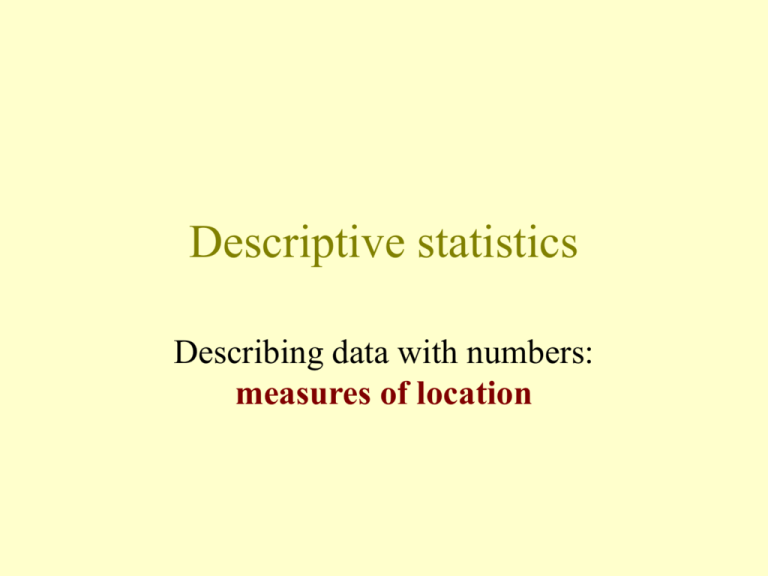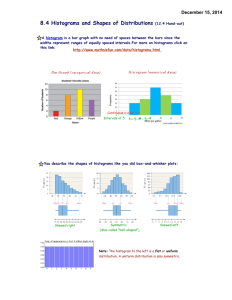location
advertisement

Descriptive statistics Describing data with numbers: measures of location What to describe? • What is the “location” or “center” of the data? (“measures of location”) • How do the data vary? (“measures of variability”) Measures of Location • Mean • Median • Mode Mean • Another name for average. • If describing a population, denoted as , the greek letter “mu”. • If describing a sample, denoted as , called “x-bar”. • Appropriate for describing measurement data. • Seriously affected by unusual values called “outliers”. Calculating Sample Mean Formula: X X n i That is, add up all of the data points and divide by the number of data points. Data (# of classes skipped): 2 8 3 4 Sample Mean = (2+8+3+4+1)/5 = 3.6 Do not round! Mean need not be a whole number. 1 Median • Another name for 50th percentile. • Appropriate for describing measurement data. • “Robust to outliers,” that is, not affected much by unusual values. Calculating Sample Median Order data from smallest to largest. If odd number of data points, the median is the middle value. Data (# of classes skipped): 2 8 Ordered Data: 1 8 2 3 4 Median 3 4 1 Calculating Sample Median Order data from smallest to largest. If even number of data points, the median is the average of the two middle values. Data (# of classes skipped): 2 8 3 4 1 8 Ordered Data: 1 2 3 4 8 8 Median = (3+4)/2 = 3.5 Mode • The value that occurs most frequently. • One data set can have many modes. • Appropriate for all types of data, but most useful for categorical data or discrete data with only a few number of possible values. In Minitab: Variable Phone Variable Phone N 139 Mean 121.6 Minimum 2.0 Median 60.0 Maximum 2000.0 TrMean 88.1 Q1 30.0 N = number of data points Sample median Sample mean StDev 217.7 Q3 120.0 SE Mean 18.5 In Minitab: • • • • • Select Stat. Select Basic Statistics. Select Display Descriptive Statistics. Select variable(s) of interest. Select OK. The most appropriate measure of location depends on … the shape of the data’s distribution. Most appropriate measure of location • Depends on whether or not data are “symmetric” or “skewed”. • Depends on whether or not data have one (“unimodal”) or more (“multimodal”) modes. Symmetric and Unimodal Percent 20 10 0 2.0 2.2 2.4 2.6 2.8 3.0 3.2 3.4 3.6 3.8 4.0 GPAs Symmetric and Unimodal 2 3 GPA 4 Symmetric and Unimodal Descriptive Statistics Variable GPA N 92 Mean 3.0698 Variable GPA Minimum 2.0200 Median 3.1200 Maximum 3.9800 TrMean 3.0766 StDev 0.4851 Q1 2.6725 SE Mean 0.0506 Q3 3.4675 Symmetric and Bimodal Symmetric and Bimodal Variable Males Females All N 84 89 176 Variable SE Mean Males 0.331 Females 0.305 All 0.303 Mean 70.048 64.798 67.313 Min 63.0 56.0 56.0 Median 70.000 65.000 67.000 Max 76.0 77.0 77.0 TrMean 70.092 64.753 67.291 Q1 68.0 63.0 64.0 StDev 3.030 2.877 4.017 Q3 72.0 67.0 70.0 Symmetric and Bimodal Skewed Right Number of Music CDs of Spring 1998 Stat 250 Students Frequency 20 10 0 0 100 200 300 Number of Music CDs 400 Skewed Right 0 100 200 Number of CDs 300 400 Skewed Right Descriptive Statistics Variable CDs N 92 Mean 61.04 Variable CDs Minimum 0.00 Median 46.50 Maximum 400.00 TrMean 52.93 Q1 21.50 StDev 62.90 SE Mean 6.56 Q3 83.00 Skewed Left 30 Percent 20 10 0 50 55 60 65 70 75 80 grades 85 90 95 100 Skewed Left Skewed Left Variable grades Variable grades N 22 Mean 89.18 Minimum 50.00 Median 93.50 Maximum 100.00 TrMean 90.60 StDev 12.92 Q1 87.00 SE Mean 2.76 Q3 98.00 Choosing Appropriate Measure of Location • If data are symmetric, the mean, median, and mode will be approximately the same. • If data are multimodal, report the mean, median and/or mode for each subgroup. • If data are skewed, report the median.





